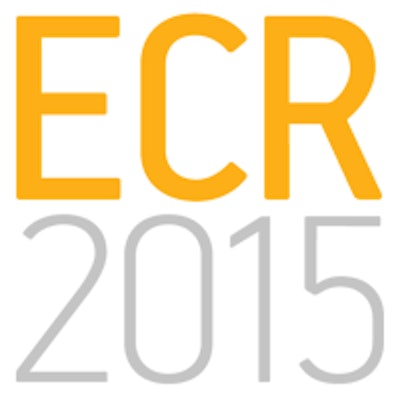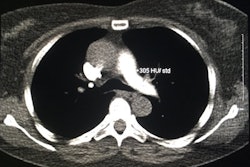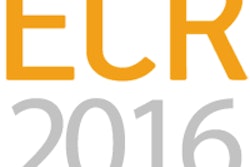
VIENNA - Radiation dose tracking software can provide many benefits, but it's important to be aware of some key issues to yield meaningful evaluation and optimization of patient dose from CT studies, according to a Saturday presentation at ECR 2015.
For example, institutions need to be aware of what they're measuring and why; understand certain technical issues related to patient size, dose, and image quality; and adhere to a standard imaging lexicon, according to Dara Murphy, a medical physicist in the radiology department at Our Lady's Children's Hospital, Crumlin (OLCHC) in Dublin.
OLCHC is part of the National Integrated Medical Imaging System (NIMIS), a national RIS/PACS initiative currently underway in the Irish healthcare system. NIMIS, which began in 2010 and is expected to be completed in 2016, includes dose tracking software (Radimetrics, Bayer HealthCare) provided under subcontract from NIMIS RIS/PACS vendor McKesson.
Currently, data from all of the CT scanners at institutions currently using NIMIS are being fed into the Radimetrics platform, essentially creating a national dose index registry, Murphy said.
It's important to understand that they are not tracking patient dose, they are tracking metrics, he said. While there's a strong belief that monitoring cumulative exposure should not have anything to do with justifying future imaging studies, tracking software can certainly assist in dose optimization, Murphy said.
Different modalities have different metrics, and while all values can be converted to an effective dose using Monte Carlo techniques, effective dose is irrelevant for assessing individual patients.
"It's a very broad kind of risk estimate for very large populations," he said. "For example, in my hospital, we're never using effective dose. It's all about organ dose and trying to basically work out what are the doses for the specific patients, not for actual populations."
Gambler's fallacy
Clinicians may not understand that cumulative radiation exposure should not affect the decision to order a CT scan.
"You may come across situations where a clinician will say, 'Look, this patient has had five CT scans and that's a lot of radiation,' " Murphy said. "Even if the sixth CT scan is justified, maybe they will not want to go ahead and do it, and they will try and order something else, even though the CT may well be justified."
Essentially, it's important to be aware of what's known as the gambler's fallacy.
"In roulette, if red comes up 10 times in a row, there's a very strong cognitive bias that black has to come up next," he said. "But, of course, the odds are actually the same every time you spin the wheel, and the same is true for radiological imaging."
While it's true that five CT scans carry higher risk than one CT scan, it does not mean that the risk accumulates and that the fifth CT scan is somehow more dangerous than the first CT scan, Murphy said.
This concept relates to the stochastic effects of radiation dose and not its effects on tissue, he said. Cumulative exposure is certainly important, for example, for interventional radiology and interventional cardiology procedures.
"But from a justification process, we would be of the view that cumulative exposure really has no role to play here," Murphy said.
Dose tracking is an enormously useful tool for optimizing CT scans, however, he added.
Optimization
Diagnostic reference levels (DRLs) have long been established as a useful way of benchmarking a hospital's radiographic practice against similar institutions. Several national dose surveys have been published in the U.K. over the past 20 years, and there are many publications detailing CT metrics for a variety of examinations. However, relying on average-sized patients of 60 kg to 80 kg, while useful for most adults, doesn't work well for nonaverage-sized adults or children.
Dose tracking allows physicians to move away from the idea of a "standard" patient and extend the DRL concept to all patient sizes, Murphy said.
Intended to optimize patient dose and image quality, CT automatic exposure control (AEC) tools feature two approaches: constant noise and adequate noise. Constant noise provides a constant noise profile for all images in the scanned volume, while adequate noise aims for lower noise in small patients and accepts higher noise for larger patients. It's important to be aware that both of these approaches will produce very different results depending on the size of the patient.
While an adequate-noise approach might appear best for larger patients, there's no reason that a scanner using the constant-noise approach can't be adapted to produce lower dose, he said.
"In pediatrics we do this all the time," he said. "We have four or five CT abdomen protocols for different weight ranges. ... If you have access to dose tracking, you can do exactly the same thing for a range of adult sizes."
While age, height, weight, and body mass index are useful metrics for AEC, performance is ultimately based on patient diameter. It's common to set up site-specific protocols for pediatrics, but it's less common to have those protocols for adults. As adults vary considerably in size, "it would seem sensible, therefore, to adopt this methodology and basically set up reference ranges based on body width," Murphy said.
Dose tracking -- or, more precisely, dose metric tracking software -- offers the possibility of automating calculation of the relevant information that influences patient dose, such as patient diameter. There's also the possibility of using information in the DICOM header (or calculated data) to identify poor technique, such as poor patient centering in CT, he said.
"You can also very quickly identify any outliers in the data," Murphy said.
The software collects all the information in the image DICOM header and calculates CT dose index volume (CTDIvol), dose-length product (DLP), and size-specific dose estimates (SSDEs), paving the way for national DRLs in Ireland.
Care is required in interpreting certain dose metrics such as CTDIvol, Murphy noted.
Potential problems
A number of problems can arise during the implementation of radiation dose tracking software, according to Murphy.
Great care is required in interpreting this type of data, he said. While using something like the RadLex Playbook is not necessary at a local level, it's an essential step at a national level -- right from the beginning -- to make meaningful comparisons between dose metrics on the same modalities.
Because Ireland didn't adopt a standard lexicon at the beginning, it was difficult to determine if they were comparing apples to apples.
"Uniformity in protocol naming is a vital step in attaining meaningful comparisons between modalities of the same type," Murphy said.
Another issue to look out for is premonitoring scans, which are common in CT pulmonary angiography (CTPA) procedures for contrast and bolus tracking and can alter DLP values.
"If the premonitoring is not being used every single time for CTPA, you can get this variability in [DLP] that looks a bit weird until you actually start looking into the individual patients, and you see that in some cases they are using premonitoring scans and in some cases they are not," he said. "Likewise, you want to be careful about mixing scans up. Something might be registered as CT brain, but in fact it may well be CT brain with contrast, which, of course, would give you double the dose."
Murphy also noted that older scanners may not be in compliance with the current International Electrotechnical Commission (IEC) definition of CTDIvol, which should be based on a single average tube current value of the entire scan. The maximum CTDIvol may be reported in some cases, resulting in erroneous comparisons with other scanners, he said.
In stationary table dosimetery, reported CTDIvol may also be incorrect due to extra scatter and inclusion of overbeaming correction that is not present when the patient is stationary.


















